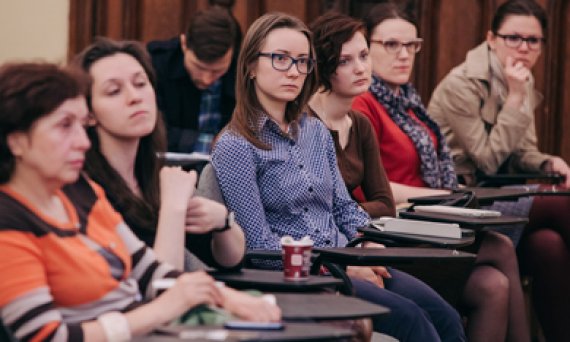From May 12th until May 15th, the European University at St. Petersburg hold a series of lectures titled “Central Asia in Focus,” organized jointly by the TAIF Professorship in the History of the Muslim Peoples of Russia and the BP Professorship in Migration Studies.
Students and guests of the University could attend lectures by Bakhtiyar Babadzhanov (Doctor of Historical Sciences), a senior research associate at the Institute for Eastern Studies at the Academy of Sciences of the Republic of Uzbekistan and a senior research associate at the Historical Institute of the Academy of Sciences of Uzbekistan and Ulfat Abdurasulov, a research associate at the Iranian Studies Institute of the Austrian Academy of Sciences.
From May 12th until May 15th, the European University at St. Petersburg hold a series of lectures titled “Central Asia in Focus,” organized jointly by the TAIF Professorship in the History of the Muslim Peoples of Russia and the BP Professorship in Migration Studies.
Students and guests of the European University could attend lectures by Bakhtiyar Babadzhanov (Doctor of Historical Sciences), a senior research associate at the Institute for Eastern Studies at the Academy of Sciences of the Republic of Uzbekistan and a senior research associate at the Historical Institute of the Academy of Sciences of Uzbekistan and Ulfat Abdurasulov, a research associate at the Iranian Studies Institute of the Austrian Academy of Sciences.
Bakhtiyar Babadzhanov’s first lecture, “Soviet Muslims in Central Asia: From Adaptation to Renaissance” was devoted to the phenomenon of Soviet Islam in Central Asia, predominately in Uzbekistan, as Tashkent was the center of all events. The ability to identify oneself as a Soviet Muslim appeared under the Bolsheviks and existed for many years. In his lecture, Babadzhanov attempted to explain why this phenomenon got rooted so quickly despite the government’s atheistic policies and repressions; which meanings Muslims themselves gave to this term, especially the political elite; how forms of religious identity changed; and how the “Soviet form of religious minimalism” was formed. Babadzhanov presented all the changes in identity through a prism of visual sources.
The second lecture, “Soviet Eastern Studies in the ‘Red East’” examined the formation of the orientalist phenomenon in the east (or, as it was then called, the “Red East”), as well as the ideological, historical and political context of this phenomenon taking as an example of the Institute for Eastern Studies at the Academy of Sciences of the Republic of Uzbekistan, in Tashkent. The history of the Institute for Eastern Studies and other similar institutions throughout the country serves as an example of the transformation of orientalist views. The Institute for Eastern Studies in Tashkent was founded in 1943 at the same time as the Central Asian Spiritual Administration of Muslims. At the time, the Institute was called the Institute of Oriental Manuscripts rather than the Institute for Eastern Studies. Its primary task consisted in describing manuscripts, initial cataloging, compiling card files and short translations of essays—one could call it academic orientalism. The Institute’s mission changed slightly in 1946 when a resolution was passed, regulating what the Institute should be engaged in. It spoke about the national heritage and the creation of national history. In addition, the focus of research within the eastern studies in the institute had to be shifted from the study of religious identity to the study of the national one. Such changes influenced the format of orientalism, creating the foundations for its Soviet type. Under conditions of forming nations or national histories, historical narratives created their own state in each region, retrospectively using the territories of neighboring states. This was a very complex process based on national ethnic narratives. The narratives formulated under Soviet authority became the most common method of constructing post-Soviet states in Central Asia.
The third lecture “‘Sacred Tablets Before Your Eyes.’ The Proclamations, Meanings and Philosophy of Arabic-Lettered Epigraphy on Medieval Monuments in Uzbekistan”, examined the function and meanings of medieval epigraphy as a part of historical memory. Babadzhanov showed photographs of the best images of inscriptions, considering them as part of the urban architectural landscape and sacred spaces that surrounded the people of past eras or decorated objects in their normal everyday lives.
Ulfat Abdurasulov’s lecture “Letter to a Tashkent Friend. The Contours of Soviet Orientalism in the Personal Correspondence of Elena Davidovich and Olga Chekhovich” allowed the audience to get acquainted with the life and work of Olga Chekhovich — a prominent scholar who ignored all the obligatory ideological clichés in her research work while being simultaneously an active member of the Communist Party who consciously put her own “I” in Soviet reality, being its advocate. Abdurasulov attempted to answer a series of questions: how could these seemingly antagonistic images coexist and to what extent did they mutually influence and complement each other? Was it a type of conformity, an attempt to protect herself from the pressures of the regime, or did Olga feel herself to be a part of socialist space and believe in its ideals? The study of Chekhovich’s personal biography has shown that the Soviet orientalist with a party card in her pocket could change both herself and the academic space around her. On the basis of a more than twenty-year personal correspondence between Chekhovich and her close friend, the renowned orientalist Elena Davidovich, Abdurasulov presented the whole spectrum of various issues discussed, the nature of the horizontal relationships in the academic environment and tried to reconstruct the boundaries of the intellectual space that was formed in the Soviet Union at its periphery. This study also served to illustrate the discussion of Soviet subjectivity and Soviet eastern studies.
Anna Matochkina






